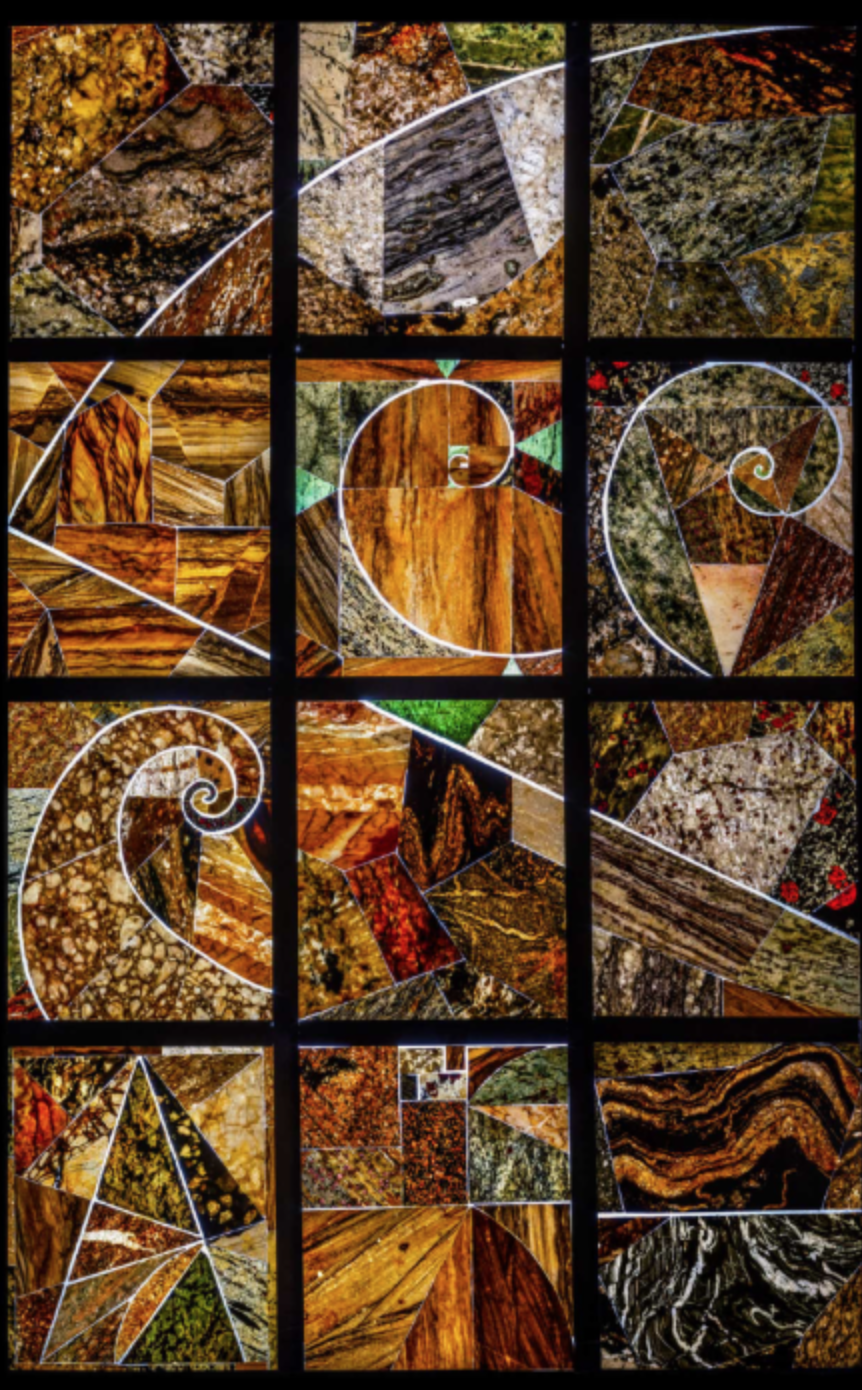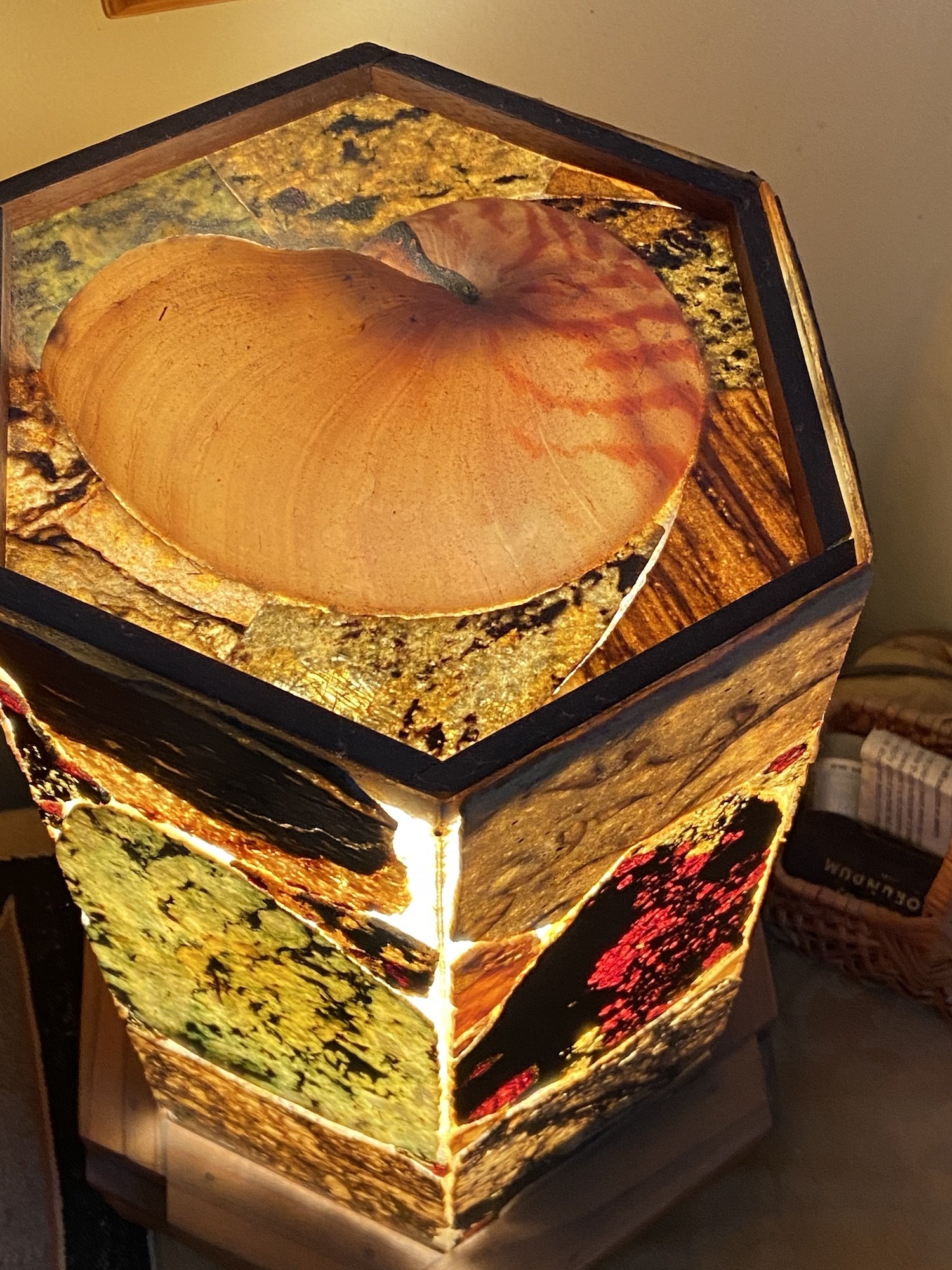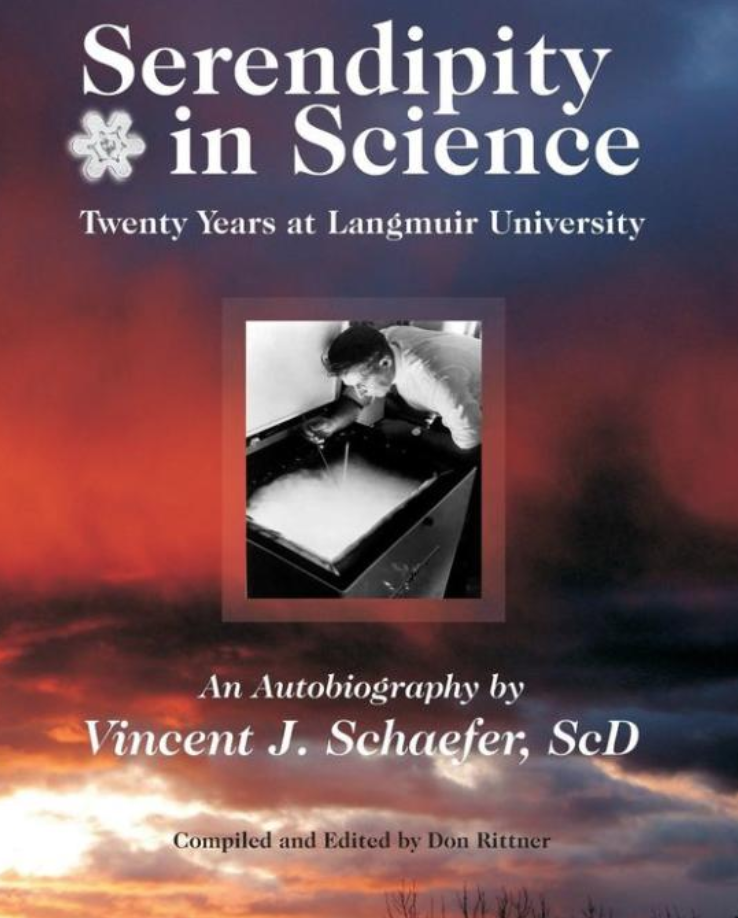Ancient Windows of the Earth
In this Ancient Window, Vince features the beauty of Italian mathematician Fibonacci's ever-present Spiral or "Divine Proportion." You’ll find more of his work, as well as rock-slice art by his brother Carl and nephew Greg, here.
A renowned atmospheric scientist, Vincent Schaefer is credited with many inventions in his long and productive career. In 20 years at General Electric. he earned 14 patents despite never graduating from high school.
He discovered cloud seeding, a technique later used for increasing precipitation in areas needing water.
He invented a machine capable of creating a fog of such density and in such copious amounts that the American military hid ships with it during World War II.
He also demonstrated for the first time that, if you sliced an Adirondack rock thinner than a potato chip using a diamond-tipped saw blade, it became translucent. When backlit, it became as beautiful as stained glass.
Then he worked with it like stained glass, creating stunningly gorgeous art.
“When I first explored the Adirondacks, I was greatly intrigued with the wide variety and beauty of the gravel, cobblestones, and boulders that were visible in all of our streams," he wrote in Serendipity in Science, the autobiography that his son Jim and historian Don Rittner assembled and published posthumously 20 years after his death.
”Many years later,” Vince continued, “I was able to obtain equipment that permitted me to polish stones by tumbling, and then cutting thin slices from the cobblestones found in streams and gravel banks. These slices disclosed the beauty of the crystalline structures they possessed.”
“After a few years,” he writes, “I was able to develop techniques so as to obtain slices as large as seven inches by twelve inches and just four one-hundredths of an inch thick.”
AN ADVOCATE FOR WILDERNESS
Referencing the structure of a snow crystal, this hexagonal lamp is topped with a Nautilus shell, a natural Fibonacci Spiral. The red slice at lower right is garnet in a matrix of gneiss, found by Vince at Barton Garnet Mines on Ruby Mountain.
The brother of wilderness advocate Paul Schaefer and ski pioneer Carl Schaefer, Vince played several important roles in the story of the Adirondacks.
First, he founded the Mohawk Valley Hiking Club which we’ve learned from Jim had its first outing on January 6, 1929. The MVHC was the core of the group that historian Franklin Graham calls the “Schenectady Force,” the group of wilderness advocates that John Apperson and Paul Schaefer mobilized to fight for the continuation and enforcement of the Forever Wild clause of the New York Constitution, the famous Article 14.
He also was instrumental in establishing skiing in North Creek, finding common interests among movers and shakers with whom ski trails were cut, thereby making it possible to bring Snow Trains filled with skiing enthusiasts and eventually making Gore Mountain a major ski destination.
In his later years in the 1970s, Vince began to collect rocks from all over the Adirondacks, focusing especially on outcrops and residues of stream and glacial action. These mountains, he wrote, offered a "happy hunting ground" unrivaled by any other place in the world, thanks to its "wide variety of strata, the vast spread of age, and the complete set of geological forces that formed these mountains."
"One of the most beautiful of the Adirondack rocks I have sliced is the garnet gneiss of Ruby Mountain found at Barton Garnet Mines," he noted.
A HOME AND WORKSHOP IN ROTTERDAM
This is the home Vincent and Lois Schaefer named Woestyne, Dutch for “wilderness.”
"He used an 18-inch diamond blade that could take rocks up to eight inches,” says Greg Schaefer, who now owns the saw, having inherited it from his father Carl, who’s renowned for bringing to North Creek the first rope-tow in New York State, powered by the engine of a 1929 Buick. Both Carl and Greg also developed mastery in Adirondack rock-slicing, as we’ll feature in a future installment of The Schaefers of Cabin Country.
“When cutting rock, some type of lubricant is needed,” Greg explains. “Drills, lathes, and sanders create dust, but the rock saw creates a ‘mist’ due to whatever oil is used. The mist can permeate and coat everything around.”
For this reason, says Greg, “I keep my saw outdoors, and mostly cut during milder weather.”
Vince eventually moved the saw to another room because it affected his mother’s respiration, Jim says.
Vince and Jim’s mother Lois lived in a home on Schermerhorn Road in Rotterdam that, in a nod to the land’s Dutch colonial past, they named Woestyne, Dutch for “wilderness.” Paul assisted in the two-year effort required to complete the house in 1936. Carl laid the brick and built the two fireplaces. Jim and his wife Kim live here today.
When Vince Schaefer upgraded to a newer model of his rock-slicer, he gave the first he bought to his brother Carl, who left it to his son Greg, who continues to practice the art Vince invented.
“My father's workshops were in the basement,” Jim says. “He had a wood-working shop, an experimental equipment room, a dark room, a microscope room, a film editing room and a writing area in front of the large limestone fireplace there. He worked in all of these rooms while conducting GE-related studies.”
“With the completion of our north addition, I now have adequate space for my machine tools, and was able to install my circular saw, turning lathe, drill press and sander, along with cabinets, shelves, and a workbench,” Vince wrote.
“When I left the Research Laboratory, I offered a token payment for all my laboratory equipment. This was accepted. Thus I was able to acquire my cold chambers, troughs, chemicals and all other equipment that I had accumulated over a 20-year period…It has served me well over the more than 20 years since I left the Laboratory, and I am still using much of it!”
CURIOUS ABOUT CRYSTALLINE STRUCTURES
In his effort to find the geological sequences of rocks he collected, Vince indexed more than 200 by type and area, marking each with a yellow number.
“Dad was curious about the patterns of crystalline structures, which allowed him to trace certain rocks to their original quarry or place where the native stone was modified or transported in the direction of the ebb and flow of the ice sheets covering the Adirondacks.,” says Jim. “He also was trying to find the geological sequences of the area from rocks he found in various locations. He labeled each stone with a yellow number, indexed more than 200 by type and area.”
"By studying the color, crystalline nature and general appearance of my slices, I have sought to trace back to the original rock formations the trajectory of the great glacier that transported the rock to where I found it," he wrote.
Through careful observation, he determined that one boulder of "pinkish, yellow porphyry" that originated from a lava flow on the western shore of Lake Champlain had been carried to a gravel bank adjacent to Rotterdam Junction along the Mohawk River above Schenectady. Another had been carried to upper waters of the Chaugtanooda Creek at the head of Wolf Hollow in the Glenville Hills, north of the Mohawk.
"This is typical of the fascinating puzzles that emerge as my collecting expeditions continue. They combine to make a life filled with intellectual fun."
VINCE’S MASTERPIECE: THE ST. JAMES WINDOW
On July 4, 1980 — his birthday — Vince Schaefer gave this six-foot hexagonal window to St. James Church in North Creek in memory of his parents.
In all, Vince created about about a dozen rock-slice works that now are held by Schaefer families. Among them are a lamp, a lampshade, three shadow boxes with rock slice designs, twin stellar snow crystals, a Fibonacci spiral tray, and six triangular ancient windows.
Then there’s the masterpiece he gave in 1980 to St. James Church of North Creek, attended by his family when they were at Woestyne North, their cabin on Chatiemac Road. Accompanying the St. James Window is a plaque dedicating the work “in loving memory of Peter Aloysius and Rose Agnes (Holtslag) Schaefer,” his parents.
Along with the window, which he “designed to relate to the North Creek Area of the Adirondack Mountains,” Vince included a simple brochure that explains the rock symbolisms, first noting that the hexagonal shape of the window symbolizes the hexagonal snow crystal, “which is an important part of the environment and economy of the region.”
A spiral in the central core unwinds toward the window’s outer edge, originating from a hexagonal quartz crystal that symbolizes the Creator. Three streams of the Trinity are represented by “Marcy and Whiteface anorthosite and gneiss, the dominant rock of the Adirondacks.”
“Garnet-bearing rock from the Gore and Ruby Mountain mines flow beyond to reach the edge of the hexagon,” the text continues. “Potsdam sandstone outlines two edges of the large hexagon. This rock is from the ancient sea, which invaded the mountains more than a half billion years ago. The final sequence are rocks grounded by the Continental Glacier, which flowed across the mountains 50,000 years ago.”







